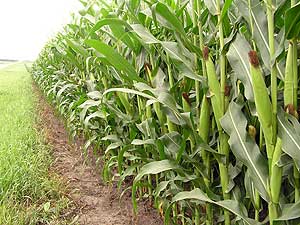|
Audio
Photos
Your Voice
|
Record Minnesota corn crop expected
August 12, 2004
 |
| Farmer Bruce Gustafson expects above average yields from his corn fields. He says warmer temperatures will help. (MPR photo/ Mark Steil) |
 | |||
Hanley Falls, Minn. — If the USDA estimates are accurate, Minnesota farmers should harvest a record corn crop this year of more than one billion bushels. Soybeans will be close to a record and much better than last year.
Bruce Gustafson farms near Hanley Falls in southwest Minnesota. Standing in a soybean field, Gustafson sizes up his harvest prospects.
"I think our crop is pretty good, but we're far behind," says Gustafson. "We planted corn, planted beans early and had such cold weather for so long they had a hard time growing. I think that's the case everywhere across Minnesota."
Even though it's early afternoon on an August day, Gustafson is wearing a jacket. A brisk north wind and cloudy skies chill the air. On the side of a farm buildings hangs an old, and as it turns out, inaccurate thermometer. Gustafson bends close to read it.
"That's warm. It's 72. We wish it was," says Gustafson. "I think I looked at noon. (It was) 62, 63. So, it's cold."
 | |||
Temperatures like that will slow crop development. It could take until October for his corn and soybean crops to be ready for harvest. That raises all sorts of concerns. A killing frost is the biggest.
"We get down in the low 40's last night, it's not too far away from the low 30's," says Gustafson. "So in August, September, that could happen I mean with the weather patterns we've been having."
Gustafson says if frost stays away, and if enough rain falls, he should have a good year. He expects average to above average crops.
He's had one good harvest already. His wheat crop was one of his best ever.
That's good news for farmers following disappointing yields last fall. Dry weather hurt the 2003 harvest.
The USDA predicts Minnesota's corn crop will be 10% greater than last year. Soybeans are looking even better, up 27% from 2003. Nationwide the corn crop is expected to set a record, nearly 11 billion bushels. The soybean crop will also be a good one, nearly three billion bushels.
 | |||
The big harvest is having a major impact on grain prices. Brian Brandt is an ag banker with Wells Fargo in Marshall.
"If you see a big spike in prices, you'll see the market go down almost as fast, or maybe faster then it went up," says Brandt.
That's what happened this year. Soybean prices skyrocketed when traders thought there might not be enough beans to go around. But as crop prospects improved through the summer prices fell, more than 40 percent in just three months.
That's like the Dow Jones stock average dropping from 10,000 to 6000. Even with the sharp drop, Brandt says prices are still high enough for farmers to make a profit.
"I think in general the mood of our local farmers here is still pretty good. Irregardless of what commodity prices, grain prices, may have done over the last month or two," says Brandt.
Farmer Bruce Gustafson managed to sell some soybeans and corn near the peak of the price boom last spring. That will help offset the lower prices farmers are seeing now.
He's also had decent prices for his cattle. He says it looks like he'll make money this year.
Bundled up against the chill, standing next to his faulty thermometer, he says weather is the one factor which could change that.
|
News Headlines
|
Related Subjects
|
